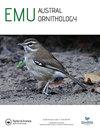出乎意料:来自两个生态不同范围的蓝鸦(Cyanocorax caeruleus)的地理变异和分化
IF 1.1
4区 生物学
Q3 ORNITHOLOGY
引用次数: 0
摘要
潜在的生物学过程往往可以塑造表型变异。虽然很微妙,但蓝鸦(Cyanocorax caeruleus)羽毛颜色的变化长期以来一直被认为具有系统地理学的重要性,但这一假设尚未得到验证。该物种在巴西东南部大西洋森林生物群系中的分布被Serra do Mar山线划分为两个生态截然不同的部分。巴拉那松(Araucaria angustifolia)种子的可用性对于西部山脉的蔚蓝鸦的生存至关重要,但在东部山脉则并非如此。在这里,我们使用三个数据集量化Azure Jay的地理变化,包括发声,形态和羽毛颜色。所有可用的资料都独立地支持东西方分化的假设。西部地区的天蓝鸦往往有:(1)更大的身体尺寸,(2)更低的音调和熵,(3)绿蓝色的羽毛,比东部地区的天蓝鸦要多。基于该物种的生态学、生活史和社会性的现有数据,我们讨论了西部范围的特征如何表明栖息地利用的专业化。我们讨论了我们的结果与大西洋森林过去之间的潜在联系,以及在高度受威胁的栖息地中对该物种保护的影响。最后,我们强调了迫切需要人口统计和分子证据,为该物种的保护提供数据导向和有效的决策。本文章由计算机程序翻译,如有差异,请以英文原文为准。
Out of the blue: geographic variation and divergence between Azure Jays (Cyanocorax caeruleus) from two ecologically distinct ranges
ABSTRACT Underlying biological processes can often shape phenotypic variation. Although subtle, the variation in plumage colour of the Azure Jay (Cyanocorax caeruleus) has long been suggested to be of phylogeographic importance, but this hypothesis was not tested. This species’ distribution in the Atlantic Forest biome of south-eastern Brazil is divided into two ecologically distinct portions by the Serra do Mar mountain line. The availability of Parana Pine (Araucaria angustifolia) seeds is essential for the survival of Azure Jays in the western range but not in the eastern range. Here we quantify Azure Jay geographic variation using three datasets, including vocalisations, morphology and plumage colour. All available data independently supported the hypothesis of divergence between east and west. Azure Jays in the western range tend to have: (1) larger body dimensions, (2) vocalisations with lower pitch and entropy, and (3) a greenish-blue plumage, than those in the eastern range. Based on the available data on this species’ ecology, life history and sociality, we discuss how features from the western range could indicate specialisation in habitat use. We discuss potential links between our results and the past of the Atlantic Forest and the implications for this species conservation in a highly threatened habitat. Finally, we highlight the pressing need for demographic and molecular evidence to make data-oriented and effective decisions for this species conservation.
求助全文
通过发布文献求助,成功后即可免费获取论文全文。
去求助
来源期刊

Emu-Austral Ornithology
生物-鸟类学
CiteScore
2.00
自引率
7.70%
发文量
33
审稿时长
>12 weeks
期刊介绍:
Emu – Austral Ornithology is the premier journal for ornithological research and reviews related to the Southern Hemisphere and adjacent tropics. The journal has a long and proud tradition of publishing articles on many aspects of the biology of birds, particularly their conservation and management.
 求助内容:
求助内容: 应助结果提醒方式:
应助结果提醒方式:


